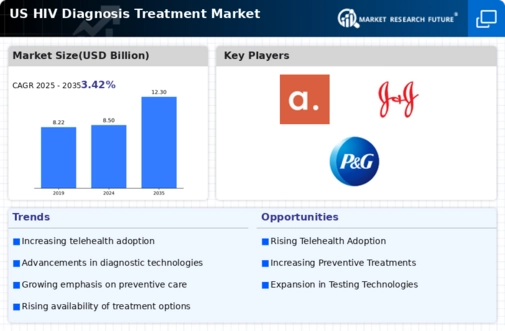The HIV diagnosis-treatment market in the US is characterized by a dynamic competitive landscape, driven by innovation, strategic partnerships, and a focus on patient-centric solutions. Key players such as AbbVie (US), Gilead Sciences (US), and ViiV Healthcare (GB) are at the forefront, each employing distinct strategies to enhance their market positioning. AbbVie (US) emphasizes research and development, particularly in the area of long-acting therapies, which could potentially transform treatment regimens. Gilead Sciences (US) continues to leverage its strong portfolio of antiretroviral therapies while expanding its focus on integrated care solutions, indicating a shift towards holistic patient management. ViiV Healthcare (GB), a company dedicated solely to HIV, appears to be strengthening its commitment to community engagement and access initiatives, which may enhance its brand loyalty and market share.
The business tactics employed by these companies reflect a concerted effort to optimize supply chains and localize manufacturing processes. The market structure is moderately fragmented, with several players vying for dominance, yet the collective influence of major companies shapes competitive dynamics significantly. This fragmentation allows for niche players to emerge, but the presence of established firms like Gilead and AbbVie creates a challenging environment for newcomers.
In October 2025, Gilead Sciences (US) announced a strategic partnership with a leading telehealth provider to enhance access to HIV testing and treatment services. This move is likely to expand Gilead's reach into underserved populations, aligning with broader public health goals and potentially increasing patient adherence to treatment protocols. The integration of telehealth solutions may also streamline patient management, reflecting a growing trend towards digital health innovations.
In September 2025, AbbVie (US) launched a new long-acting injectable formulation for HIV treatment, which could significantly reduce the frequency of dosing for patients. This innovation not only positions AbbVie as a leader in treatment convenience but also addresses adherence challenges faced by many patients. The introduction of such therapies may reshape treatment paradigms and enhance patient outcomes, thereby solidifying AbbVie's competitive edge.
In August 2025, ViiV Healthcare (GB) initiated a community outreach program aimed at increasing awareness and testing for HIV in high-risk populations. This initiative underscores ViiV's commitment to social responsibility and may foster stronger relationships within communities, ultimately driving patient engagement and treatment uptake. Such strategic actions reflect a broader trend towards corporate social responsibility in the healthcare sector.
As of November 2025, the competitive trends in the HIV diagnosis-treatment market are increasingly defined by digitalization, sustainability, and the integration of artificial intelligence (AI) in treatment protocols. Strategic alliances are becoming more prevalent, as companies recognize the value of collaboration in enhancing service delivery and patient outcomes. Looking ahead, competitive differentiation is likely to evolve from traditional price-based strategies to a focus on innovation, technological advancements, and supply chain reliability. This shift may redefine market dynamics, emphasizing the importance of patient-centric approaches and the need for companies to adapt swiftly to changing healthcare landscapes.

















Leave a Comment